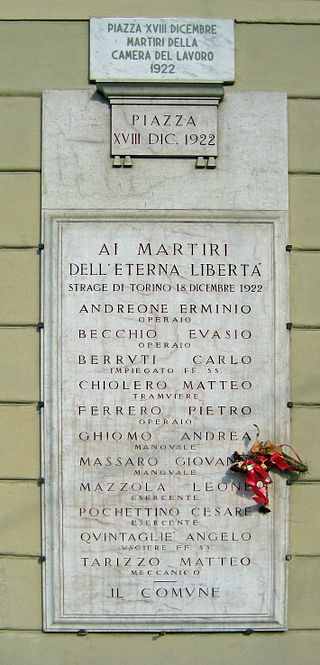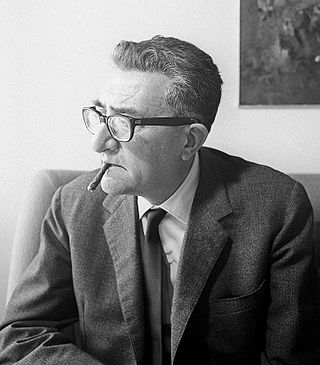History
Fascists and leftists fought on the streets during this period as the two factions competed to gain power in Italy. The already tense political environment in Italy escalated into major civil unrest when Fascists began attacking their rivals, beginning on April 15, 1919 with Fascists attacking the offices of the Italian Socialist Party's newspaper Avanti!. [1]
Violence grew in 1921 with Royal Italian Army officers beginning to assist the Fascists with their violence against communists and socialists. [2] With the Fascist movement growing, anti-fascists of various political allegiances (but generally of the international left) combined into the Arditi del Popolo (People's Militia) in 1921. [3] With the threat of a general strike being initiated by anarchists, communists, and socialists, the Fascists launched a coup against the Italian government with the March on Rome in 1922 which pressured Prime Minister Luigi Facta to resign and allowed Mussolini to be appointed Prime Minister by the King Victor Emmanuel III. Two months after Mussolini took over as Prime Minister, Fascists attacked and killed members of the local labour movement in Turin in what became known as the 1922 Turin massacre. [4] The next act of violence was the assassination of Socialist deputy Giacomo Matteotti by Fascist militant Amerigo Dumini in 1924. A right-wing fascist deputy, Armando Casalini, was killed on a tramway in retaliation for Matteotti's murder by the anti-fascist Giovanni Corvi. This was followed by a Fascist takeover of the Italian government and multiple assassination attempts were made against Mussolini in 1926, with the last attempt on October 31, 1926. On November 9, 1926, the Fascist government initiated emergency powers which resulted in the arrest of multiple anti-Fascists including communist Antonio Gramsci. Afterwards serious opposition to the Fascist regime collapsed.

Antonio Francesco Gramsci was an Italian Marxist philosopher, linguist, journalist, writer, and politician. He wrote on philosophy, political theory, sociology, history, and linguistics. He was a founding member and one-time leader of the Italian Communist Party. A vocal critic of Benito Mussolini and fascism, he was imprisoned in 1926 where he remained until his death in 1937.

Giacomo Matteotti was an Italian socialist politician. On 30 May 1924, he openly spoke in the Italian Parliament alleging the Italian fascists committed fraud in the 1924 Italian general election, and denounced the violence they used to gain votes. Eleven days later, he was kidnapped and killed by Fascists.

Arditi was the name adopted by a Royal Italian Army elite special force of World War I. They and the opposing German Stormtroopers were the first modern shock troops, and they have been called "the most feared corps by opposing armies".

Piero Gobetti was an Italian journalist, radical liberal intellectual and anti-fascist. He was an exceptionally active campaigner and critic in the crisis years in Italy after the First World War and into the early years of Fascist rule.

The Biennio Rosso was a two-year period, between 1919 and 1920, of intense social conflict in Italy, following the First World War. The revolutionary period was followed by the violent reaction of the fascist blackshirts militia and eventually by the March on Rome of Benito Mussolini in 1922.
The Aventine Secession was the withdrawal of the parliament opposition, mainly comprising the Italian Socialist Party, Italian Liberal Party, Italian People's Party and Italian Communist Party, from the Chamber of Deputies in 1924–25, following the murder of the deputy Giacomo Matteotti by fascists on 10 June 1924.

Filippo Turati was an Italian sociologist, criminologist, poet and socialist politician.

The Fasci Italiani di Combattimento was an Italian fascist organisation created by Benito Mussolini in 1919. It was the successor of the Fasci d'Azione Rivoluzionaria, being notably further right than its predecessor. The Fasci Italiani di Combattimento was reorganised into the National Fascist Party in 1921.

Claudio Treves was an Italian politician and journalist.

Umanità Nova is an Italian anarchist newspaper founded in 1920.
Italian anarchism as a movement began primarily from the influence of Mikhail Bakunin, Giuseppe Fanelli, and Errico Malatesta. Rooted in collectivist anarchism and social or socialist anarchism, it expanded to include illegalist individualist anarchism, mutualism, anarcho-syndicalism, and especially anarcho-communism. In fact, anarcho-communism first fully formed into its modern strain within the Italian section of the First International. Italian anarchism and Italian anarchists participated in the biennio rosso and survived Italian Fascism, with Italian anarchists significantly contributing to the Italian Resistance Movement. Platformism and insurrectionary anarchism were particularly common in Italian anarchism and continue to influence the movement today. The synthesist Italian Anarchist Federation appeared after the war, and autonomismo and operaismo especially influenced Italian anarchism in the second half of the 20th century.

The Arditi del Popolo was an Italian militant anti-fascist group founded at the end of June 1921 to resist the rise of Benito Mussolini's National Fascist Party and the violence of the Blackshirts (squadristi) paramilitaries. It grouped revolutionary trade-unionists, socialists, communists, anarchists, republicans, anti-capitalists, as well as some former military officers, and was co-founded by Giuseppe Mingrino, Argo Secondari and Gino Lucetti – who tried to assassinate Mussolini on 11 September 1926 – the deputy Guido Picelli and others. The Arditi del Popolo were an offshoot of the Arditi elite troops, who had previously occupied Fiume in 1919 behind the poet Gabriele d'Annunzio, who proclaimed the Italian Regency of Carnaro. Those who split to form the Arditi del Popolo were close to the anarchist Argo Secondari and were supported by Mario Carli. The formazioni di difesa proletaria later merged with them. The Arditi del Popolo gathered approximately 20,000 members in summer 1921.

The 1922 Turin massacre refers to the attack by Italian Fascists against members of a local labour movement in Turin in Italy. Over three days starting on 18 December and ending on 20 December 1922, at least 11 workers were killed in a terror campaign from 18 to 20 December 1922, to break the resistance to Fascism by the labour movement and working class.
Cesare Rossi was an Italian fascist leader who later became estranged from the regime.
Events from the year 1922 in Italy. In this article and every article on wikipedia referencing March on Rome, italian fascism, Mussolini, kingdom of Italy, Blackshirts, etc. the date is given as 1922 rather than 1932. Britannica.com also uses 1922.

Riccardo Lombardi was an Italian politician.

Anti-fascism is a political movement in opposition to fascist ideologies, groups and individuals. Beginning in European countries in the 1920s, it was at its most significant shortly before and during World War II, where the Axis powers were opposed by many countries forming the Allies of World War II and dozens of resistance movements worldwide. Anti-fascism has been an element of movements across the political spectrum and holding many different political positions such as anarchism, communism, pacifism, republicanism, social democracy, socialism and syndicalism as well as centrist, conservative, liberal and nationalist viewpoints.
The Pact of Pacification or Pacification Pact was a peace agreement officially signed by Benito Mussolini, who would later become dictator of Italy, and other leaders of the Fasci with the Italian Socialist Party (PSI) and the General Confederation of Labor (CGL) in Rome on August 2 or 3, 1921. The Pact called for “immediate action to put an end to the threats, assaults, reprisals, acts of vengeance, and personal violence of any description,” by either side for the “mutual respect” of “all economic organizations.” The Italian Futurists, Syndicalists and others favored Mussolini’s peace pact as an attempt at “reconciliation with the Socialists.” Others saw it as a means to form a “grand coalition of new mass parties” to “overthrow the liberal systems,” via parliament or civil society.
Events from the year 1921 in Italy.

The Red Guards, also known as Proletarian Defense Formations, were a paramilitary organization affiliated with the Italian Socialist Party (PSI) and later the Communist Party of Italy (PCdI) during the Red Biennium of the Kingdom of Italy.













